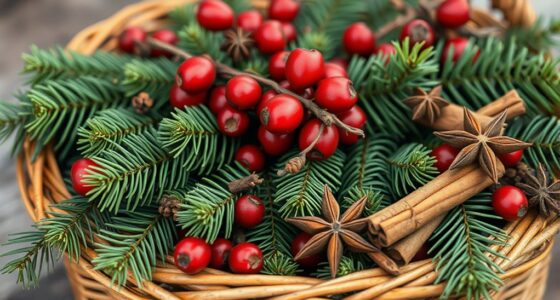In late winter, you can tap sugar maples and birch trees to harvest sap easily and sustainably. Drill small, shallow holes into the bark, insert spouts, and collect the sap in containers—no fancy gear needed. Boil the sap gently to concentrate its sugars into syrup, adjusting temperature carefully. Proper timing and mindful tapping help protect the trees, ensuring a plentiful harvest each season. Keep exploring to learn how to perfect your syrup-making process step by step.
Key Takeaways
- Late winter, with fluctuating temperatures around freezing, is ideal for collecting sap from birch and maple trees.
- Drill shallow holes and insert spouts to sustainably harvest sap without harming the trees.
- Collect sap in clean containers, then boil it slowly to concentrate sugars into syrup.
- Proper timing and technique ensure healthy trees and high-quality, natural syrup.
- The process fosters a personal connection to nature, emphasizing tradition and environmental respect.

Have you ever wondered why late-winter is the perfect time to tap into maple trees for sap and syrup? It’s a moment of harnessing nature’s raw energy, a chance to break free from the constraints of store-bought sweetness and forge your own liquid gold. This season offers a unique opportunity to connect directly with the land, using simple yet effective sap collection methods that empower you to gather what you need and turn it into something extraordinary. You don’t need fancy equipment—just a few taps, containers, and a keen eye. As temperatures fluctuate around freezing during the day and dip below at night, the trees respond by sending sap upward, giving you the perfect window to harvest.
When it comes to sap collection methods, simplicity is your ally. You can drill small holes into the bark of sugar maples or birch trees, insert spouts or spiles, and let the sap flow into buckets or tubing systems. The key is to place your collection containers in a way that minimizes contamination and maximizes flow. These methods are not only efficient but also respectful of the tree’s health—using shallow taps and allowing the tree to recover ensures sustainable harvesting. To further protect the health of your trees, understanding tuning laws can help you stay within legal limits and avoid potential issues. Once you’ve collected enough sap, it’s time to focus on syrup processing techniques. This stage is where your liberation from mass-produced sugar becomes evident. You’ll boil the sap, removing excess water to concentrate its natural sweetness. The process demands patience—slow, steady heat that transforms a watery liquid into a thick, amber syrup. A good rule is to boil until the syrup reaches about 219°F (104°C), or until it reaches the desired consistency and clarity.
Throughout this process, you take control. You decide how much to collect, how to process it, and ultimately, how to enjoy your creation. No need for commercial shortcuts—your syrup is a product of your effort, your connection to the seasons, and your respect for nature’s rhythms. You can experiment with filtration methods to clarify the syrup further or add subtle flavors if you wish, but the core remains: you’re using simple techniques to reveal a treasure trove of flavor. Late winter is a time of transformation—not just for the trees, but for you as well. By mastering these sap collection methods and syrup processing techniques, you’re reclaiming a piece of nature’s bounty, forging a sense of independence rooted in tradition, skill, and the pure joy of creating something genuine with your own hands.
Frequently Asked Questions
How Do I Identify the Best Trees for Tapping?
You can identify the best trees for tapping by focusing on healthy, vigorous trees with good sap flow. Look for trees with smooth bark and no signs of disease or damage. Maples and birches with strong, steady sap flow during late winter are ideal. Avoid weak or unhealthy trees, as they won’t produce quality sap. Tapping healthy trees liberates their full potential, giving you richer, more abundant syrup.
What Tools Are Essential for Late-Winter Tapping?
You’ll need a sharp drill, tapping spiles, and collection containers for late-winter tapping. Make certain the trees are healthy and suitable for tapping, avoiding any with damage or disease. Timing is vital—tap when the sap flow is at its peak, usually early to mid-winter. By using the right tools and monitoring tree health and tapping timing, you can efficiently harvest sap and enjoy the process of liberation through your own syrup.
How Do Weather Conditions Affect Syrup Quality?
You’ll notice weather patterns and temperature fluctuations dance together, shaping your syrup’s quality. When days warm up and nights cool down, sap flows smoothly, producing sweet, pure syrup. But erratic weather can cause inconsistent sap flow, leading to cloudy or less flavorful syrup. Embrace the unpredictability, and your syrup becomes a symbol of nature’s wild spirit, offering you freedom from strict rules and a taste of true wilderness.
Can Sap Be Collected From Trees Other Than Birch and Maple?
Yes, you can collect sap from alternative trees like birch, walnut, and sycamore. These trees have unique sap compositions that can be tapped for syrup or sweet drinks, giving you the freedom to explore beyond traditional options. By experimenting with different species, you open up new flavors and enjoy a broader range of natural resources. Embrace the chance to liberate your palate and connect with nature’s diverse bounty.
What Are Common Mistakes to Avoid During Tapping?
Watch out for sap collection pitfalls that could ruin your syrup. Don’t drill too deep or damage the tree’s essential bark — it’s a mistake that affects syrup quality and tree health. Avoid rushing the process; patience ensures purity. Forgetting to sanitize equipment invites contamination. Stay attentive, respect nature’s limits, and you’ll enjoy the freedom of crafting delicious, pure syrup without costly mistakes.
Conclusion
As you explore late-winter sap and syrup, remember that tapping birch and maple trees is like revealing nature’s secret treasure chest. With patience and care, you’ll enjoy the sweet rewards of your efforts, just as a gardener appreciates the first bloom of spring. Embrace the process, and you’ll find that each drop of sap is a reminder of nature’s resilience and generosity, turning cold months into a time of sweet anticipation and discovery.










